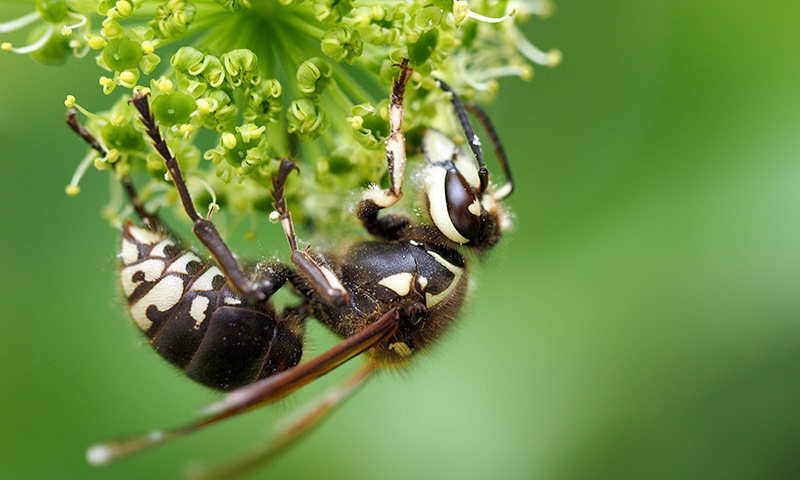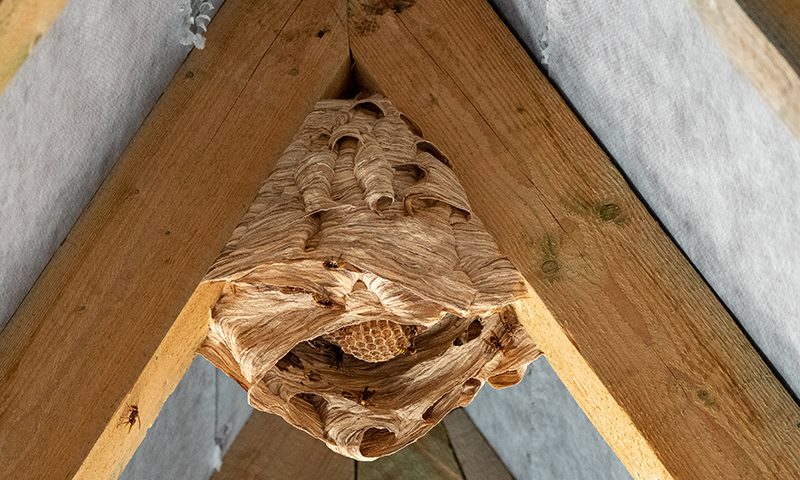How to Kill and Control Hornets
Many homeowners worry about the difference between hornets and wasps. In reality, the differences are minor. Hornets are types of wasps. The wasp family includes what scientists call "true hornets." It also contains many wasps that people in some regions call hornets instead. Whether pests disrupting your life are true hornets or hornets in name only, control is the same. By understanding these pests and their habits, you can get rid of hornets and protect against hornet nests and stings.

Common hornets feed on nectar, plant sap and other insects.
Understanding Hornets
Thousands of wasp species exist in North America, but only one true hornet is common here. The European hornet, also called the brown hornet or giant hornet, is a nonnative insect that has spread in the United States since the mid-1800s.1 This common hornet should not be confused with the Asian giant hornet, also known as the murder hornet, an extremely dangerous pest recently introduced to the Pacific Northwest.
European hornets grow up to 1.5 inches long — about three times larger than common wasps. Their yellow-banded, reddish-brown bodies have narrow, pinched waists, minimal hair, reddish-brown heads and yellow faces. In contrast, Asian giant hornets grow 2 inches or longer and have bright yellow-orange heads.
Other wasps that go by the common name "hornet" include bald-faced or white-faced hornets. These North American natives grow less than 1 inch long and have creamy white markings on their faces and abdomens.
"Ground hornet" is a common name applied to several types of ground-dwelling wasps, depending on geography. In the Northeast, ground hornets may be large, solitary sand wasps. In the Midwest, the name can refer to solitary black digger wasps or any ground-dwelling wasp colonies, including yellow jackets. These varied "hornets" average from .5 inches to 1.5 inches long.

Bald-faced hornets are native wasps, not true hornets.
Identifying Hornet Nests
Common European hornet nests can be hard to locate. These social insects live together in large annual colonies built in tree cavities, outbuildings and occasionally wall voids in homes. Sometimes, the only clue to the large, hidden, papery nest is the sight of hornets coming and going as they forage and feed on nectar, tree sap and insects. Other times, small parts of their nests protrude from openings.
Bald-faced hornets create large, gray, papery nests that hang like footballs from tree limbs. Ground hornet nests range from tiny holes housing single wasps to massive underground colonies, where thousands of wasps live in papery combs built from chewed wood pulp. Entries to these nests may be a single hole in the ground or a large dirt pile with a center hole. Many solitary ground hornets nest alone but stay close to others. In these cases, you'll find many small holes in one area of your lawn.
European hornets are generally not aggressive unless threatened. Then they'll defend their nests tenaciously. "Ground hornets" that live in colonies do the same. As with other colony-dwelling wasps, hornet nests only last for one year. Each fall, new queens disperse to overwinter elsewhere, and the rest of the colony dies. Hornets do not reuse their nests from year to year. If you need to remove a large, active hornet nest, consider contacting a pest professional first.

Hornet nests appear in places from hollow trees to house eaves.
Protecting Against Hornets
Most common wasps fly during daytime hours, but European hornets are an exception. These stinging insects also fly at night. Drawn to light — including flashlights of curious homeowners — they're often mistaken for window-banging June beetles. For best results, treat hornets at dusk. Always use caution and keep your distance when treating these pests. Unlike honeybees, which can only sting once, hornets and other wasps can sting people and pets repeatedly.
With Amdro Quick Kill® Insect Killer for Lawn & Landscape Ready To Spray or Amdro Quick Kill Insect Killer for Lawn & Landscape Concentrate, you can kill existing hornets and protect against new hornets as well. These easy-to-use, residual pesticides work in minutes to kill hornets by contact. Then they keep protecting treated areas for up to three months. You can treat lawns, trees, shrubs, flower gardens and your home's foundation up to a maximum height of 2 feet.
By understanding hornets and their habits, you can focus your efforts and get rid of disruptive hornets, hornet nests and stings. At Amdro, we're here to help you reclaim your yard and your peace of mind. It's time to get back to enjoying your yard with family and friends.
Always read product labels and follow the instructions carefully.
Sources:
1. M. Waldvogel, et al., "European Hornets – Biting and Stinging Pests," North Carolina State Extension.


